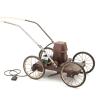DIY for the plan
Progress reports on the production plan were routine in the GDR economy.
Production quotas were set by the state bureaucracy and had to be met by every workshop, administration or farm. This chart offers a survey of the production of a state run horticulture branch and shows a selection of the different vegetables, fruit and flowers cultivated.
The blue strip indicates the planned quota and the red indicates the current state of production. Endive and cabbage turnip had been produced well beyond the plan while lettuce and rhubarb came up short.
Since ready-made charts weren´t available in the plan economy the nursery made their own of hook and eye fasteners and elastic ribbon normally used for making clothes.
 Previous Story
Next Story
Previous Story
Next Story
How to cite this page
Andreas Ludwig, 'DIY for the plan', Inventing Europe, http://www.inventingeurope.eu/story/diy-for-the-plan
Sources
- Abc des Ostens. 26 Objektgeschichten, edited by Dokumentationszentrum Alltagskultur der DDR. Cottbus, 2003.
- Alltag: DDR. Geschichten, Fotos, Objekte, edited by Dokumentationszentrum Alltagskultur der DDR. Berlin: Ch. Links, 2012.
- Fortschritt, Norm & Eigensinn. Erkundungen im Alltag der DDR, edited by Dokumentationszentrum Alltagskultur der DDR. Berlin: Ch. Links, 1999.
- Guter Rat, Verlag für die Frau, Leipzig, 1965-1990 (formerly Guter Rat für heute und morgen).
- Krössin, Dominque. “Wie mach ich´s mir selbst? Die Zeitschrift practic und das Heimwerken”, in: Wunderwirtschaft. Die DDR-Konsumkultur in den 60er Jahren, edited by the Neue Gesellschaft für bildende Kunst,160-165. Köln, Weimar, Wien: Böhlau, 1996.
- Magazin für Haus und Wohnung. VEB Verlag für Bauwesen Berlin.
- Merkel, Ina. Utopie und Bedürfnis, Die Geschichte der Konsumkultur in der DDR. Köln/Weimar/Wien: Böhlau, 1999.
- Practic. Verlag Junge Welt, Berlin, 1967-1990 (formerly: Modellbau und Basteln).
- Wunderwirtschaft. Die DDR-Konsumkultur in den 60er Jahren, edited by the Neue Gesellschaft für bildende Kunst. Köln, Weimar, Wien: Böhlau, 1996.




















